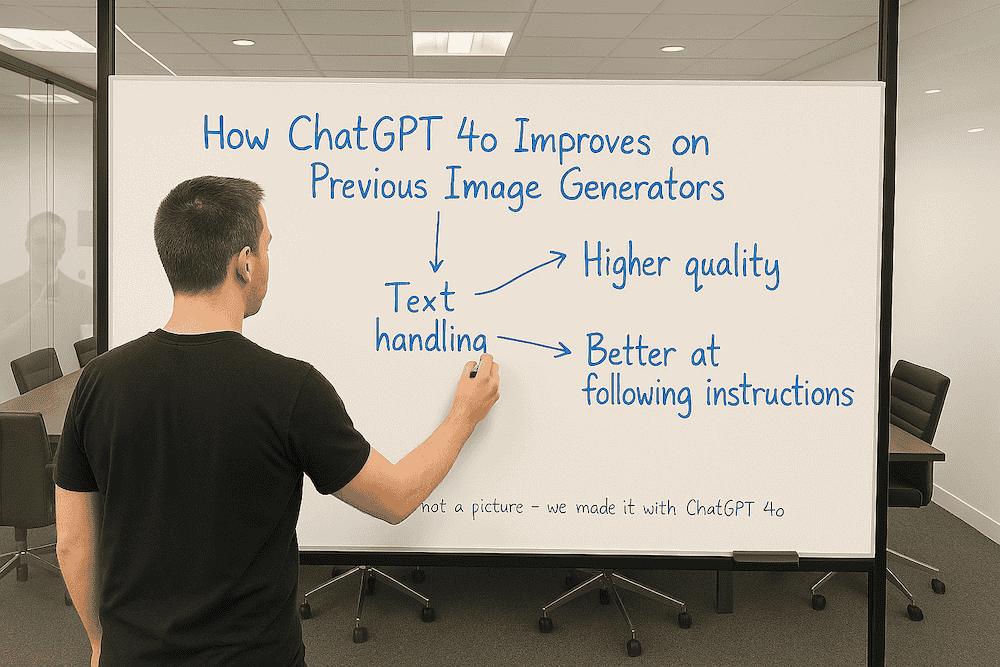Everyone’s Talking About ChatGPT’s New Image Generator

If you were scrolling pretty much any social media channel this weekend, you may have see the tidal wave of images people have been creating using the new ChatGPT image generator. I have to admit that I’ve spent more than a reasonable amount of time using it to redesign my apartment, come up with ideas for new logos, and redesign websites.
What’s the big deal?
Until now, we’ve had a variety of image generators including Midjourney, Meta AI, and OpenAI’s own DALL-E, but the new 4o model from OpenAI is dramatically more useful.
A major update people noticed is its ability to replicate styles, which sparked the Ghibli trend where people are uploading their own images to be recreated in the famous Japanese animation style (this sparked a lot of controversy, which we’ll cover below).

Next, the model does a much better job of maintaining the structure of the uploaded image, which is why people have been uploading photos of their homes and offices, then asking ChatGPT to act as an interior designer to redesign their spaces.

But the development that may have the greatest impact on our work as marketers is the accuracy of elements like text, logos, and other graphical elements. Until now, AI-generated images would garble text and morph logos, making them unusable. Now, we can create infographics, text-bases images, and pretty much anything we can imagine.
Is this the end for graphic designers?
Unsurprisingly, graphic designers are nervous. If we can create whatever we want by simply entering a prompt, why would we need to pay for professional services?
CTV News interviewed one such designer who had a bit of a different take. Devon Pastorius, owner and creative director at Windsor Creative, said “You still have to come up with the idea in the first place. It’s still being directed by a human.”
Just like writing, or programming, these tools are giving everyone the ability to make anything we can imagine, but very few of us have the skills or creative innovation to produce something excellent, even with these superhuman abilities. What makes great design is much more than moving pixels around – it’s the ability to understand both the brand and its audience in order to tell a story, or create a great user experience.
So while production designers may see fewer requests in their inbox for simple images, the need for truly creative people to lead those projects is unchanged.
Still, questions remain about the ethics and responsibility of using AI-generated content in our work.
AI-generated controversy
The aforementioned Studio Ghibli AI trend apparently reached the original artist himself, Hayao Miyazaki, who has been a vocal critic of AI-generated art.
People are citing a pretty damning quote from Miyazaki, who in 2016 said: “I am utterly disgusted. If you really want to make creepy stuff you can go ahead and do it. I would never wish to incorporate this technology into my work at all,” adding, “I strongly feel that this is an insult to life itself.”
Clearly, he’s not a fan, and he’s not alone.
The New York Times, and a group of Canadian news outlets are currently suing OpenAI in separate lawsuits, claiming the models are using their content as training data, allowing users to replicate their work without compensation or attribution. Meanwhile, a group of independent artists have banded together to sue a variety of AI companies for the same reason.
The fact is, when we generate anything using AI tools, the training data that enables it had to come from somewhere, and overwhelmingly those creators are not receiving any benefit, while the AI companies are building multi-billion-dollar market caps off of their work.
So what?
History, as they say, may not repeat itself, but it rhymes.
In the early days of the internet, it seemed impossible to reign in copyright issues, as anybody could post, share, and claim anything as their own.
Over the past few decades, through a combination of laws, lawsuits, and established norms, we have at least reached a general understanding of what is and isn’t allowed when it comes to digital content.
AI attribution may seem like an impossible question right now, but that’s because it’s so new. Over the coming months and years, judges, regulators, and the court of public opinion will help us to form standards for how we use these tools.
In the meantime, my advice is simple: If you would feel comfortable with everyone knowing that you used AI to generate your work, then it’s probably okay. And if you do choose to use AI-generated work, you should disclose it the same way you would any other type of content.
But that’s just my opinion. I’d love to hear your thoughts about this fast-moving issue. Is AI image generation the best thing to happen to marketing since the invention of the internet? Should we be afraid that it will take all of our jobs? Let us know by replying to this email.


